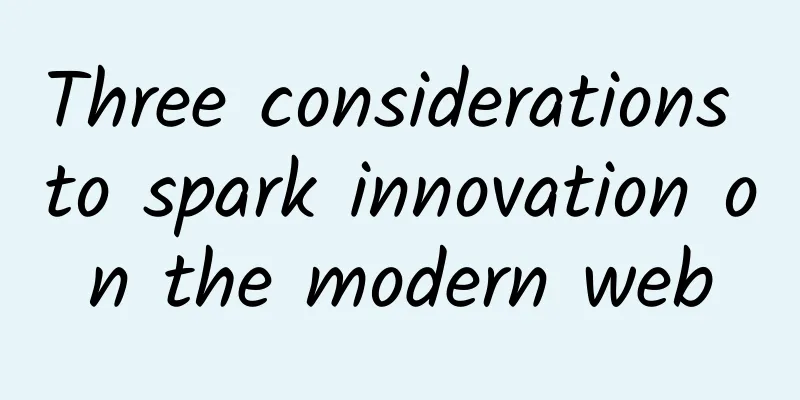Getting started with Serverless quickly | Getting started lesson 1

|
1. From Cloud Computing to Serverless Since the birth of the world's first general-purpose computer ENIAC (left), the development of computer science and technology has never stopped. From 2003 to 2006, Google published these three very classic papers (right), which pointed out the technical foundation and future opportunities of HDFS (distributed file system), MapReduce (parallel computing) and HBase (distributed database), laying the foundation for the development direction of cloud computing. So from ENIAC to Google's three classic papers, the development of computer science and technology is constantly advancing. In the era of cloud computing, it can be said that the development of computer science and technology is advancing rapidly. Cloud computing concept There are different understandings of cloud computing in academia and industry. Let's review the development history of cloud computing: 1. In 2006, Google CEO first proposed the concept of cloud computing at the Search Engine Conference; in the same year, Amazon sold its elastic computing capabilities as cloud servers, marking the official birth of cloud computing as an emerging business model; 2. In 2008, Microsoft launched the cloud computing platform Windows Azure, attempting to host and online its technology and services; 3. In 2009, the Berkeley Cloud Computing White Paper was published, which clearly stated the definition of cloud computing: cloud computing includes application services on the Internet and the hardware and software facilities that provide these services in data centers. After clarifying the definition, Berkeley proposed a vision for cloud computing and also pointed out 10 problems facing cloud computing, such as service availability, data loss, or data security and auditability. 2. Serverless Concept Serverless Definition Serverless is translated into Chinese as "serverless". The so-called serverless does not mean that there is no need to rely on resources such as servers, but that developers no longer have to consider server issues too much and can focus more on product code. At the same time, computing resources also begin to appear as services rather than as the concept of servers. Serverless is a complete process for building and managing a microservice architecture, allowing users to manage user application deployment at the service deployment level rather than the server deployment level. The difference from the traditional architecture is that it is completely managed by a third party, triggered by events, exists in a stateless state, and is temporarily stored (may only exist in the process of one call) in the computing container. Serverless deployment of applications does not involve more infrastructure construction, and can basically realize automatic construction, deployment and startup of services . Serverless Architecture On the left is the traditional and more common architecture of Web applications, which is composed of elements such as the client, server, and database. In the past, when doing such projects, developers needed to do a lot of operations on the server side, such as purchasing servers, considering the purchase quantity, bandwidth, operating system, deployment zones, environment, software, etc. Then, they also needed to monitor the health of the server in real time and constantly perceive it. Under the Serverless architecture, developers only need to worry about their business code. During the entire development, launch, and maintenance process of the project, users do not need to pay attention to server-level maintenance, nor do they need to invest in operation and maintenance resources for traffic peaks and troughs. This part will be taken care of by cloud vendors. At the same time, under the Serverless architecture, users do not need to make additional expenditures for idle resources. Serverless Advantages The serverless architecture has the characteristics of zero server operation and maintenance and no computing cost when idle; its delivery mentality can be reflected in leaving the complexity to cloud vendors and bringing convenience to more developers. In summary, the advantages of serverless can be reflected in the following: 1) Reduce costs and improve efficiency Cloud vendors provide users with server management and operation and maintenance, and provide users with Baas services such as databases and object storage, allowing users to focus more on their own business logic, improve R&D efficiency, and shorten the project innovation cycle. At the same time, Serverless users do not need to worry too much about their own server operation and maintenance, infrastructure operation and maintenance, etc., and do not need to incur additional expenses for this part, and do not need to bear more operation and maintenance costs. Serverless architecture provides a relatively complete and comprehensive pay-as-you-go model, and users only need to pay according to the actual amount of resources they use. Serverless architecture has a clear advantage in this regard. Reduce operation and maintenance costs Reduce labor costs Improve R&D efficiency Reduce innovation cycle Pay-as-you-go and reduce expenditure costs 2) Safe, convenient and reliable Hand over more professional things to more professional people. The Serverless architecture hands over more server operation and maintenance and security-related matters to cloud vendors, greatly improving the overall security of the project. At the same time, the Serverless architecture is obviously simpler than other architectures because more Baas services are provided by cloud vendors, and users will manage fewer components, which means that Serverless users can manage projects more simply and conveniently. At the same time, the Serverless architecture has elasticity, that is, the ability to automatically scale, which allows the project to automatically expand when traffic increases and automatically scale down when traffic decreases, thereby ensuring the security and stability of the entire business. The professional team ensures security and performance for users, which makes the Serverless architecture: Lower security risks, smaller resource overhead, in line with the "green" computing concept, easier to manage elastic scaling, and more reliable services. Overall, after being hosted by a cloud vendor, not only can the overall security and stability of the project be greatly improved, but the Serverless architecture is also significantly simpler than other architectures. Challenges Although the Serverless architecture has been around for many years, it has only entered its "first year" and has developed rapidly. Therefore, although the Serverless architecture has many advantages, it also faces some difficulties and challenges, including but not limited to serious cold start problems, imperfect development tools, and vendor lock-in. However, in recent years, the popularity of the Serverless architecture has continued to rise, people have high hopes for it, and various vendors have also increased their investment. I believe that the current problems are temporary, and the Serverless architecture will continue to evolve in the direction of being better and easier to use. While the Serverless architecture provides users with a new programming paradigm, the shortcomings of Serverless are gradually exposed when users are enjoying the first wave of technical dividends brought by Serverless. For example, the cold start problem of functions is a serious and concerned problem nowadays. Since the Serverless architecture has the ability of elastic scaling, the provider of Serverless services will increase or decrease instances according to the traffic fluctuations of user services, as shown in the figure. Taking Alibaba Cloud Function Compute as an example, when the system receives the first event that triggers a function, it will start a container to run the code. If a new event is received at this time, and the first container is still processing the previous event, the platform will start a second code instance to process the second event. This automatic zero-management horizontal scaling of the Serverless architecture will continue until there are enough code instances to handle all workloads. Of course, it is not only in concurrent situations that function cold starts are more likely to be triggered. When the time interval between the two triggers of the function exceeds the threshold of the instance release time, the function cold start will also be triggered, as shown in the following figure. However, there is a problem here. When a new request or event arrives, the following two situations may occur in a broad sense: There are idle instances that can be reused directly: hot start. 3. Typical application scenarios After several years of development since its proposal, the Serverless architecture has already had many best practices in many fields. CNCF has summarized some scenarios that the Serverless architecture is suitable for. Real-time file processing In scenarios such as video applications and social applications, the amount of images, audio and video uploaded by users is often large and frequent, which places high demands on the real-time and concurrency capabilities of the processing system. For example, for images uploaded by users, multiple functions can be used to process them separately, including image compression and format conversion, to meet the needs of different scenarios. Data ETL processing Usually, to process big data, you need to build a big data framework such as Hadoop or Spark, and have a cluster to process data. With Serverless technology, you only need to continuously store the acquired data in object storage, and use object storage related triggers to trigger the data splitting function to split the related data or tasks, and then call the related processing function. After the processing is completed, it is stored in the cloud database. Function computing's nearly unlimited scalability allows users to easily perform large-volume data calculations. The Serverless architecture can concurrently execute multiple mapper and reducer functions on source data to complete the work in a short time. The entire process can be simplified as shown in the following figure; compared with traditional working methods, the use of the Serverless architecture can better avoid idle waste of resources, thereby saving costs. Machine learning (AI reasoning and prediction) After the AI model is trained, when providing inference services to the outside world, the Serverless architecture can be used to wrap the data model in a calling function and run the code when the actual user request arrives. Compared with traditional inference prediction, the advantage of this is that both the function module and the backend GPU server, as well as other related machine learning services connected, can be paid-as-you-go and automatically scaled, thereby ensuring performance while also ensuring service stability. Web Application/Mobile Application Backend By combining the Serverless architecture with other cloud products provided by cloud vendors, developers can build elastically scalable mobile or web applications and easily create rich serverless backends. These programs can run with high availability in multiple data centers without having to perform any management work in terms of scalability, backup and redundancy. Audio and video transcoding In scenarios such as video applications and social applications, users will upload some videos, which are usually transcoded, including conversion to different resolutions. After combining Serverless technology with object storage-related products, object storage-related triggers can be used. That is, the uploader uploads the video to the object storage, triggering the serverless architecture computing platform (FaaS platform) to process it, and then re-store it to the object storage. At this time, other users can choose the encoded video to play, and can also choose different resolutions, as shown in the figure. In summary, the typical application scenarios of the Serverless architecture are more determined by the characteristics of the Serverless architecture. Of course, as time goes by, the Serverless architecture is also evolving, its characteristics will become more prominent, and its disadvantages will be compensated. 4. Serverless Product Introduction Public cloud products Since the concept of Serverless was proposed, it has gone from being unknown to attracting attention over the past few years. Serverless architecture is also developing rapidly. In Serverless architecture, computer services are usually provided by Faas platforms. AWS Lambda, Google Cloud Functions, Alibaba Cloud Function Compute, etc. are all representative industrial products. Faas platforms listed by CNCF Alibaba Cloud Serverless The Serverless architecture has very high requirements for the underlying technical foundation. As can be seen from the figure, Alibaba Cloud's overall Serverless architecture is very complete, and it has been continuously improving on the road of self-building and self-development. Alibaba Cloud Serverless products have been implemented within the Alibaba economy, and have been well reflected in Taobao, Alipay, Xianyu, Fliggy, DingTalk, and Yuque. Function Compute is the most complete and feature-rich Serverless product in China. It will become a reality for developers to go to the cloud and turn to Serverless in one step. The above figure shows some analysis of Alibaba Cloud Serverless from the product dimension, and the figure below expresses the typical business capabilities of Serverless from the function or architecture, underlying infrastructure, and computing level. For example, elastic scaling, load balancing, traffic control, high-availability deployment, version grayscale fault recovery, etc. Alibaba Cloud launched the container image service at runtime last year, and AWS, Tencent, etc. have also launched container images one after another. The figure explains how Alibaba Cloud Serverless gradually builds from the bottom layer to the upper layer, allowing developers to use Serverless more simply and conveniently. Open Source Products Not only are there many manufacturers in the industry working hard on the Serverless architecture, there are also many excellent Serverless projects in the open source field. Many excellent open source FaaS platforms, including OpenWhisk, Fission, Knative, and Kubeless, have been recognized by CNCF. |
<<: Edge computing and 5G drive post-pandemic economic recovery
Recommend
Do you know how to use a switch? The correct way to connect a switch
In the era of popular Internet, many families hav...
8 Internet startups that could change the industry
The current network industry seems to no longer f...
What is missing from licensing 5G for commercial use?
On February 20, South Korea announced the officia...
The theory that 5G is useless continues to exist, but 5G will determine the future era of the Internet of Everything
Since 2019, countries have successively issued 5G...
External tools connect to SaaS mode cloud data warehouse MaxCompute practice
This sharing will be explained from four aspects....
Friendhosting's new Romania VPS starts from 2.99 euros per month, 25% off down payment
Friendhosting has sent out an email about a new n...
The role of 5G in the digital economy and its impact on the industry
5G networks are being hailed as the next-generati...
RAKsmart bare metal cloud/cloud server 30% off, physical server flash sale starting from $30/month, cluster server/high bandwidth server special price
This month, RAKsmart's new bare metal cloud p...
Five technology trends everyone must prepare for in 2024
Machine intelligence, the blurring of the lines b...
Which Ethernet (Cat5, Cat5e, Cat6, Cat6a) cable should I use?
Not all Ethernet cables are created equal. What a...
Interview with Tong Yongyue: Will CDN that advocates "standard size" have bigger moves in the future?
As the infrastructure of the Internet, CDN has be...
There have been three waves of "network withdrawal" around the world. When will domestic operators complete the withdrawal of 2/3G networks?
Recently, Ericsson released the ten-year special ...
Hizakura: €17.99/year-AMD Ryzen7950x/1GB/15GB/4TB/Netherlands data center
The tribe once shared information about Hizakura,...
Asia Pacific to account for 60% of global 5G connections by 2026
[[422145]] According to new market research, ther...
CMIVPS updated pricing, US/Hong Kong VPS monthly payment starts from US$6/annual payment 30% off
I have shared information about CMIVPS many times...
![[Closed] NextArray: $1.09/month KVM-1GB/10GB/1TB/Dallas Data Center](/upload/images/67cabfc4b732a.webp)








